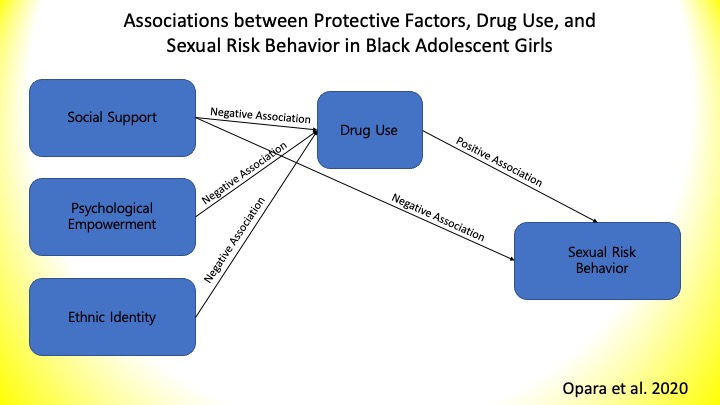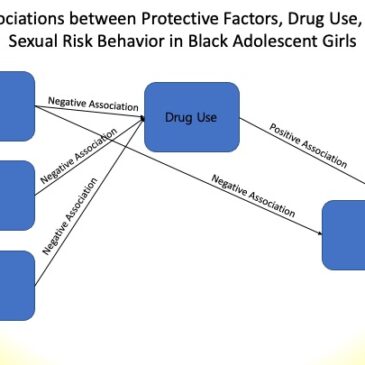Editor’s Note: In recognition of the ongoing importance of highlighting the vital contributions that Black academics make to addiction science, The BASIS is featuring the research and opinions of Black scholars of addiction. Today’s review is part of our Black History Month Special Series.
Black adolescent girls are more likely to have poor sexual outcomes, including sexually transmitted infections, than their White or other ethnic minority counterparts. Because sexual risk behavior in adolescent girls often is accompanied by drug use, preventing drug use in Black adolescent girls might aid in reducing risky sexual behavior. Unfortunately, most studies that look at risk behavior in Black adolescent girls do not consider the protective factors that could make Black girls resilient and mitigate risky behavior. This week, as part of our Black History Month Special Series, we review a study by Ijeoma Opara and colleagues of the relationships among psychological empowerment, ethnic identity, social support, drug use, and sexual risk behavior through a strength-based resiliency approach.
What was the research question?
Are Black girls who feel socially supported, psychologically empowered, and proud of their ethnic identity less likely to use drugs, and in turn less likely to engage in sexual risk behavior?
What did the researchers do?
Data for this study was collected as part of a comprehensive needs assessment in an urban community in New Jersey to help create a program to prevent drug use and sexual risk behaviors among racial and ethnic minority youth. The researchers targeted students from eight public high schools. At each public school, they surveyed students from health and physical education classes. In total, 340 14–17-year-old Black girls completed a survey measuring social support in the adolescents’ lives, psychological empowerment, ethnic identity, sexual risk behavior, and past 30-day drug use.
The researchers used path analysis to evaluate the relationships among psychological empowerment, social support, and ethnic identity on sexual risk-taking behavior using past 30-day drug use as a mediator. This means they created a model testing the hypothesis that social support, psychological empowerment, and ethnic identity help reduce drug use and, in doing so, help reduce sexual risk behavior.
Author’s Notes, Dr. Ijeoma Opara: “Building a case for why researchers should focus on strengths and internal processes such as empowerment was a challenge, as sexual health research among Black girls is often viewed through a deficit lens. I was tired of combing through articles that talked about risk factors, high prevalence rates of drug use, HIV and STIs among Black girls, without examining the strengths of Black girls who are engaging in healthy protective behaviors. My goal is to change the narrative of how Black youth, especially girls, are portrayed in research. By using strengths such as ethnic identity and empowerment that can be fostered by supportive structures, I want to develop prevention interventions that utilize strengths already present in Black families, communities, and youth.”
What did they find?
Opara and the other researchers determined that social support had a direct negative relationship with sexual risk behavior. This means that independent of other factors, girls who felt socially supported were less likely to engage in risky sexual behavior. On the other hand, they also observed that girls who reported drug use were more likely to report sexual risk behavior. Finally, drug use mediated the relationship between the three protective factors and sexual risk behavior; that is, girls who were high in social support, ethnic identity, and psychological empowerment were less likely to use drugs and in turn less likely to engage in sexual risk behavior (see Figure).
Author’s Notes, Dr. Ijeoma Opara: “I was surprised at how relevant intrapersonal empowerment (leadership competency and policy control) was on drug use and sexual risk behavior. It motivated me to push back on the negative stereotype of Black girls being seen as bossy or intimidating and instead, encourage the nurturing or leadership and advocacy skills at an early age. This can have a direct impact on the behavior’s girls engage in and their health overall. Very little research has been conducted in this area and I believe these findings have the potential to reshape how we create prevention programs for Black girls.”

Figure. The figure shows the model used to determine the associations between social support, psychological empowerment, ethnic identity, drug use, and sexual risk behavior. All the pathways shown here were statistically significant. Click image to enlarge.
Why do these findings matter?
If drug use is associated with sexual risk behavior and these protective factors reduce drug use, it stands to reason that reducing drug use among Black adolescent girls may then reduce sexual risk behaviors. It also stands to reason that prevention and intervention programs against sexual risk behavior should incorporate more strength-based approaches based on psychological empowerment, social support, and ethnic identity. Tailoring these programs to the cultural experiences of adolescent Black girls can increase the likelihood of positive outcomes.
Every study has limitations. What are the limitations in this study?
This was a cross-sectional study; the participants reported on these factors all at once. Because of the nature of the study we can’t definitely conclude that certain factors caused changes in other factors. Additionally, adolescent Black girls are not a homogenous group. Various ethnicities (e.g. African and Caribbean) can cause significant differences within this group. A deeper study across multiple ethnicities could lead to more culturally specific and helpful prevention and intervention programs.
For more information:
Are you worried that you or someone you know has an addiction? The SAMHSA National Helpline is a free treatment and information service available 24/7. Please check out this page to learn more about social media and drug use. For more details about addiction, visit our Addiction Resources page.
— Karen Amichia
What do you think? Please use the comment link below to provide feedback on this article.




